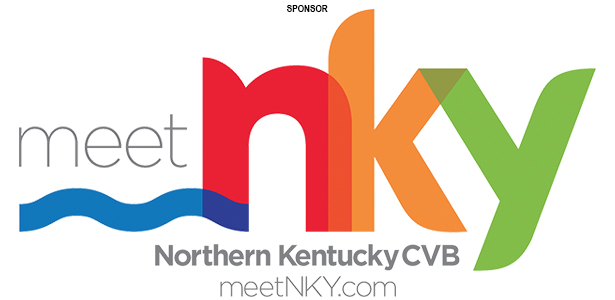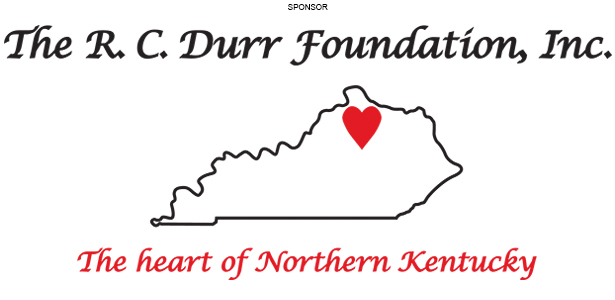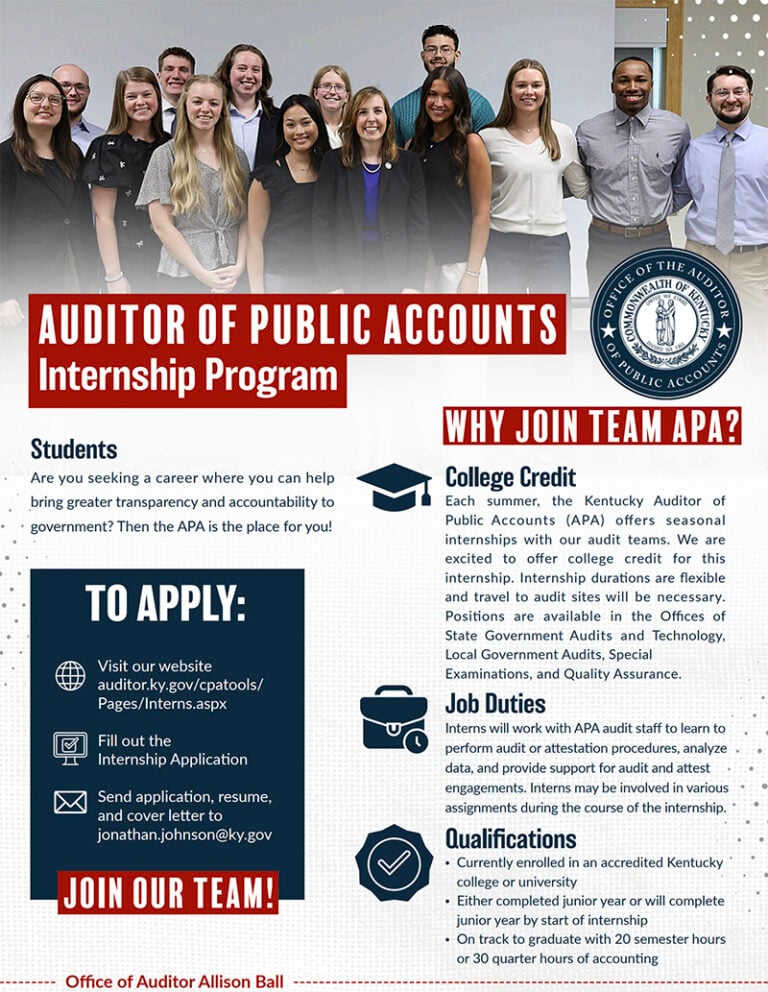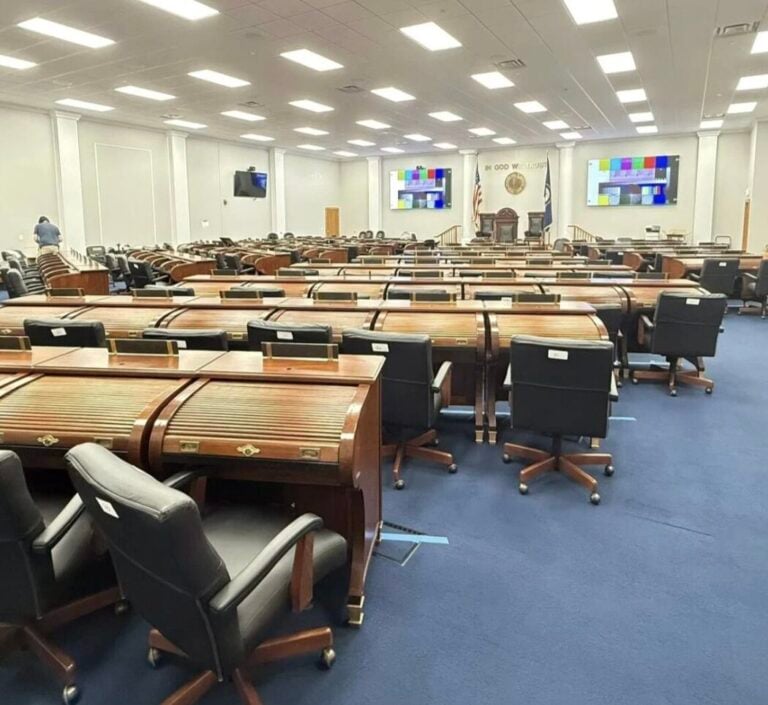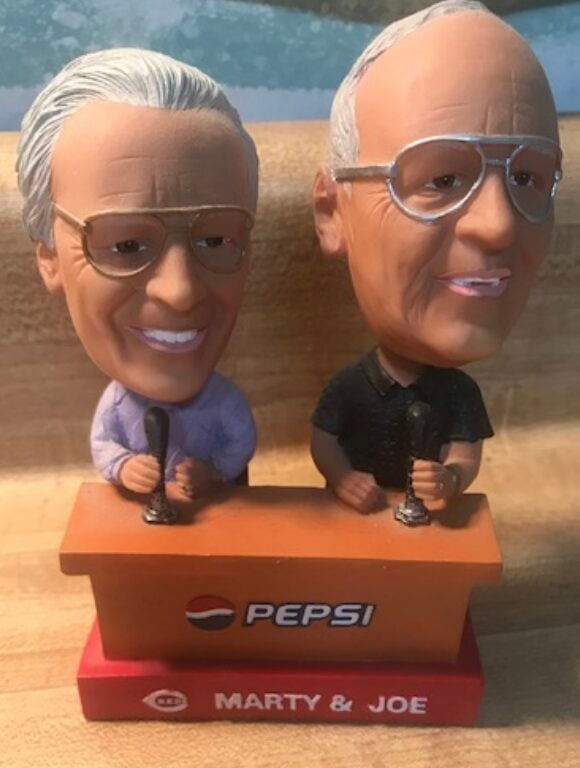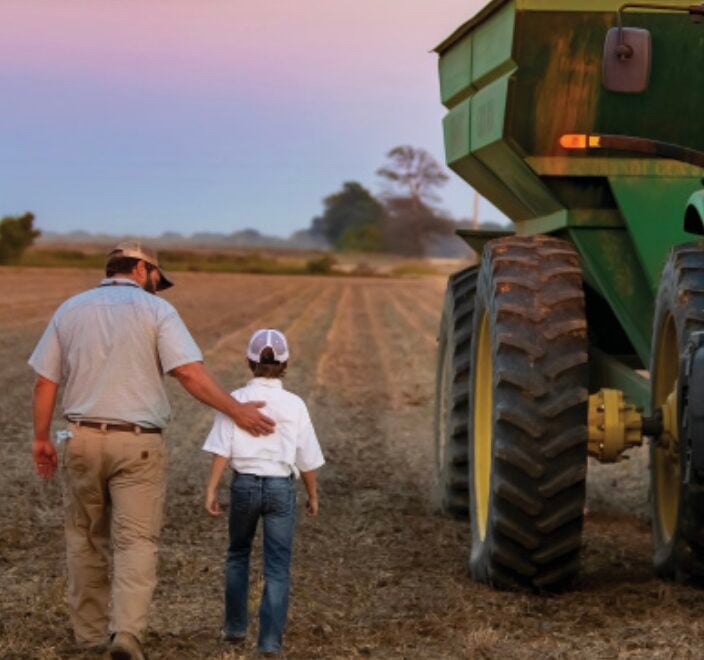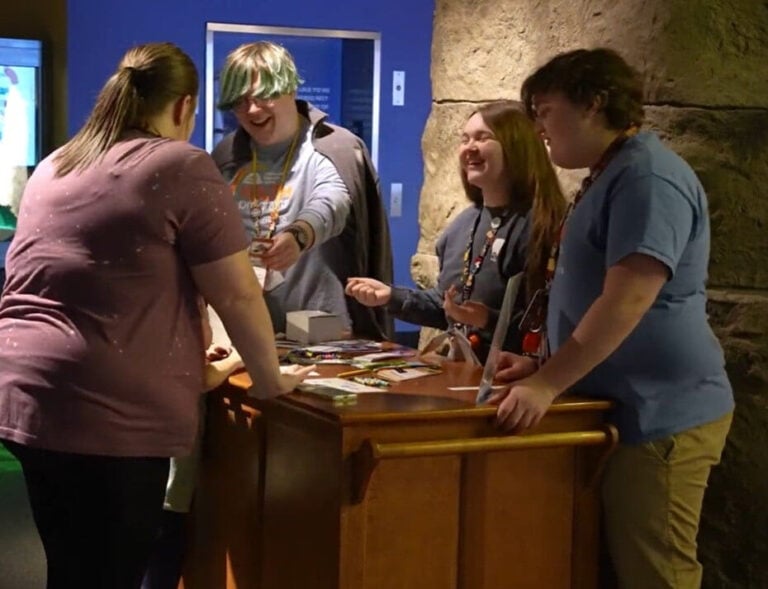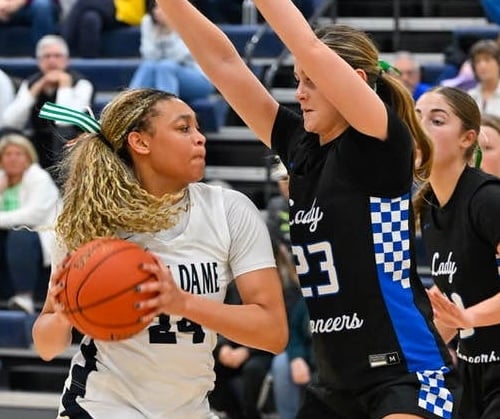The riverboat captain is a storyteller. Captain Don Sanders shares the stories of his long association with the river — from discovery to a way of love and life. This a part of a long and continuing story.
By Capt. Don Sanders
Special to NKyTribune
How far would you go to ride a steamboat? There was the day I’d journey across the country to set foot aboard one. Then why was I so reluctant to climb into my car and drive 100 miles to Louisville to ride the 111-year-old steamboat BELLE OF LOUISVILLE a week ago? I felt like a fool and nearly chickened out.
Reflecting on my reluctance, I haven’t been much further than that for hospital and doctor visits in the past six years since COVID-19 shut down everything, and then my wife and I suffered a rash of serious personal medical events. Factor in that I’m in my 9th decade, and no longer have that devil-may-care attitude of youth. Hopefully, the world will forgive my hesitance to strap on a late model motor vehicle and assume an Indy 500-style position on the winding, traffic-choked asphalt and cement highway to Falls City.
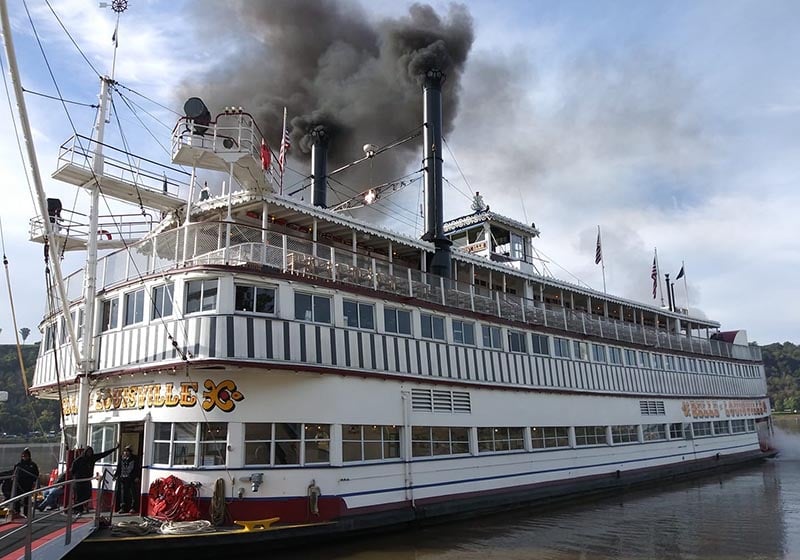
By the time Interstate 71 tore through the edge of my family’s ancestral old Kentucky Homeplace in Carroll County, my bravado returned. One again, I held my own in the race toward Louisville. Just past noon, boarding time for the BELLE, “Old Blue,” turned into the entrance of the Blue Wharf Lot at Joe’s Crab Shack, formerly a steep cobblestone grade where the Steamer AVALON landed my first time in Louisville so long ago.
“Ten dollars,” demanded the stout woman collecting tolls from her automobile parked at the entrance. “And go all the way to the end of the lot.” Once at the far end of the parking lot, a perfectly outlined space awaited just yards away from the landing barge. It looked too good to be true, but I clipped my handicap sticker onto the mirror mount and hoped Old Blue’d still be there when I returned and not towed away to the Louisville impounding lot.
The BELLE of LOUISVILLE, built in Pittsburgh in 1914 at James Rees & Sons as the IDLEWILD for the West Memphis Packet company as a packet, ferry, and excursion boat, had a long queue of passengers eagerly awaiting to get aboard. The early Sunday afternoon, though moderate in temperature, had a bright Sun shining directly overhead. Instead of getting in line, I walked toward the stern of the BELLE and watched the paddlewheel slowly turning as the engineers warmed up the steam engines, working the condensation from the cylinders. Several minutes later, I joined the line and began the process to board the BELLE.
As I’ve been a season pass holder supporting the BELLE and her sisterboat, the MARY R. MILLER, for the past several years, this was my first time to make use of my annual subscription. Surprisingly, an envelope was waiting for me with all the necessary instructions, including a stick-on badge identifying me as a pass holder. Next, the soft voice of a young officer clad in a traditional white shirt with shoulder boards bearing two gold stripes, politely, but firmly asked, “May I inspect your bag?”
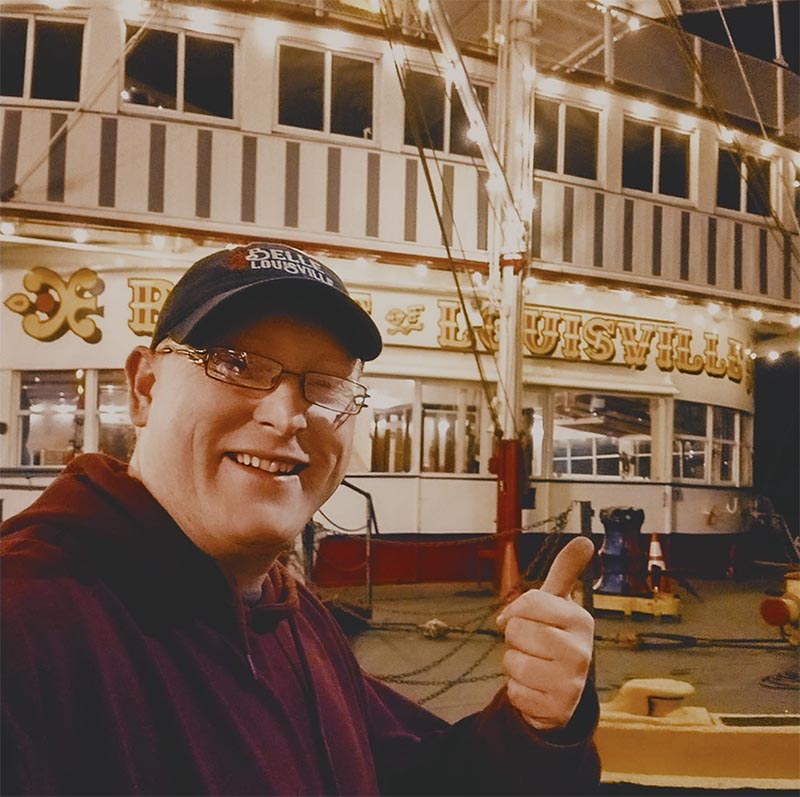
Opening the canvas bag I carried with a copy of my book, THE RIVER, a small notepad, and a printed copy of my story about steamboat Fireman, Ed Smith, I asked, “Are you the mate?” “No, I’m the lead deckhand,” he replied. “Where then, may I find the mate?” The lead man, later identified as a three-year veteran of the BELLE, Avery Cox, turned his head toward the bow of the BELLE and nodded toward another officer wearing three stripes on his shoulders — “That’s him.”
The next step in line was to wait for a photograph taken with the BELLE in the background. I begged off having my picture taken as Mate Matt Kemp called me by name, “Hey, Cap’n Don — it’s good to meet you finally and have you aboard the boat.”
Although Matt and I have long enjoyed an electronic relationship on Facebook, this was our first personal encounter. Matt and I talked for a few moments until I spied a lean figure wearing four stripes sitting inside the dimly-lit interior of the BELLE’s wharfboat, the MAYOR ANDREW BROADDUS.
“Who’s your captain, I see over on the wharfboat?”
“That’s Captain Jamie Donahue. Wanna go over and say hi?”
Gingerly, I made my way across the bow of the BELLE onto the BROADDUS and visited with Cap’n Jamie for the first time in quite a spell. “I’ll catch ya later on the BELLE,” I remarked as I left to find the best seat on the Hurricane Roof to watch the BELLE depart for the cruise up the Ohio River.
Back on the bow of the steamboat, deckhand Jonah Wright stepped up to say hello. Jonah, the son of the retired railroad engineer and now veteran steamboatman and “poet laureate” of the BELLE, John Paul Wright, is a recent member of the deck crew with a promising future ahead of him on the river.
At the top of the Grand Staircase, doors now enclose the “dancefloor” and concession stands on the Boiler Deck. Inside the doors, newly-installed air-conditioning refreshes the area over the boilers, which, before, was roasting-hot on such a summer day.
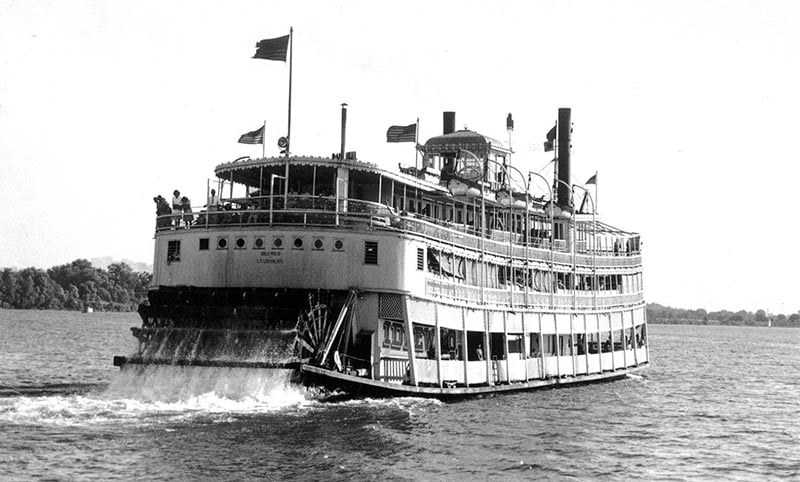
During my two seasons aboard the AVALON, flyers touted the steamboat as “glass-enclosed and air-cooled.” The AVALON, as I soon learned, was “glass-enclosed” when the windows were down, and “air-cooled” when they were up. As a traditionalist, I am generally opposed to change, but offering air-conditioning is best for today’s patrons, who are used to it. My generation only found A/C in movie theaters and the occasional store boasting, “It’s cool inside!” on a sticker in the establishment’s front window.
While most of the 300 passengers aboard the BELLE wore as little as possible for the season, I dressed in a white shirt and a vintage DELTA QUEEN tie from the 1970s, plus a black sweatshirt, figuring that once underway, the steady wind blowing downstream would be chilly. But still tied to the BROADDUS blocking the breeze, with the Sun directly overhead, I was warm, but not unbearably so.
Once on the Texas Deck, I looked for the area by the starboard smokestack, which my family usually claimed when we rode the AVALON as early as 1955. Back then, comfortable couches were perfect for a home base for my mother, father, and three riverboys eager to explore the boat. Our dad, police officer Jess Sanders, Jr., secured parking spaces for patrons along the Covington riverbank, opposite Cincinnati, for the AVALON’s annual “Covington Day” when the boat came to town.
For his efforts, Dad always received a thick pack of yellow passes for the AVALON. We rode quite often over the years and became good friends with Captain Arthur J. “Red” Schletker and Cap’n “Bo” Allen, both veteran steamboat men from the early 20th Century. Today, however, no comfy couches grace the Texas, but the chairs placed there now are full.
Another vantage point of old was at the forward handrail on the Hurricane Roof overlooking the bow, where I often stood and watched in amazement at the crack crew of deckhands below performing their departure and arrival routines. I wanted to become one of them so much that I often dreamed of it while I was still a teenager.

Soon after I found a chair overlooking the bow, I decided to walk astern and look at the paddlewheel still warming up for departure. A cloud of condensed steam from the steering gear wafted up from the wheel like a hot fog.
“Hey, Captain Don,” a familiar voice rang out. It was Cap’n Alex Schuchter from BB Riverboats. After exchanging pleasantries, Alex left to visit the pilothouse, and I went back to my roost high above the front deck to watch the BELLE’s departure coming up within a few minutes. “I wanna see how good these deckhands are,” I told Alex as we parted company.
At 12:50, double-up lines connecting the BELLE to the wharfboat and the concrete landing came off. Downbound, off the BELLE portside, a string of empty rake barges shoved by the Ingram towboat JAMES L. HAMILTON crept slowly past, heading for the Portland Canal and McAlpine Lock. Nine minutes later, the last passengers, a family of four, straggled aboard. Moments later, Mate Matt Kemp called, “BREAK UP,” as the deck crew began their ballet of rhythmic movements preparing the steamboat to depart the Louisville landing as it has countless times since the Spring of 1963.
Upon the roof of the BELLE, three distinct clangs of the ancient Vanduzen & Tift bronze bell announced departure. As the last sharp clap rang out, the raspy, iron-throated three-chimed whistle bellowed once, twice — three short blasts. She’s backing, I assumed. But instead of leaving the dock and heading away from shore, the BELLE dropped down only a few yards and held fast to the headline. Slowly, the stern worked its way outboard as Captain Donahue instructed Pilot Pete O’Connell to position the stern far out into the river. As soon as the BELLE dropped below the BROADDUS, though, a cool, refreshing breeze picked up, making me glad I wore my sweatshirt.
From my perch two decks above the bow, I watched Mate Kemp and his charges as the heavy steamboat backed around on a single capstan line. The Mate stared astern intensely at something, or someone, behind my line of sight. Perhaps he had his eyes glued on Captain Jamie on the wing bridge high above my head. The tight headline squealed as the stern swung further outboard. Pilot/Captain Pete was allowing the BELLE to swing as long as she was willing to give him as much clearance from the shore as possible.
Suddenly, the distinct cry, “LET GO!” With engines stopped, the deck crew unraveled the turns from around the capstan, freeing the steamboat from the wharfboat. “ALL GONE,” came the cry from the bow as Cap’n Pete came ahead on both engines, shoving the BELLE OF LOUISVILLE into the current and the downstream breeze. We were underway, and the sweatshirt never felt better.
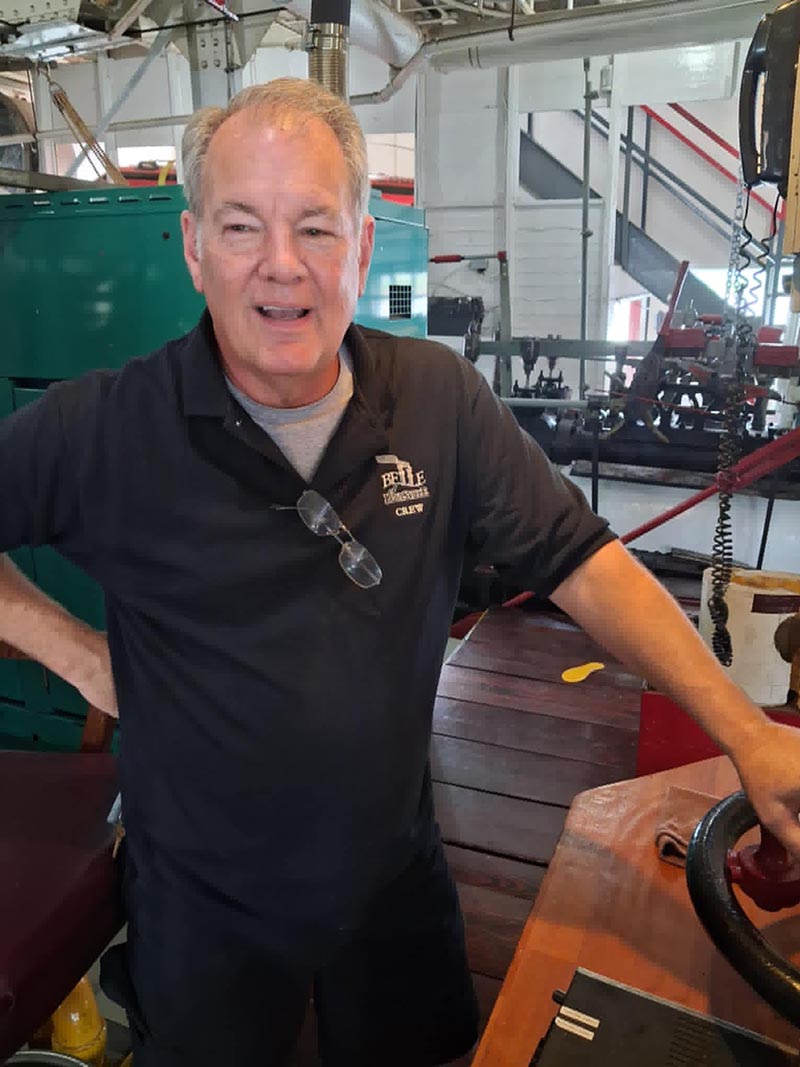
Once underway, I strolled aft to see the paddlewheel operating on a FULL AHEAD bell. Yep, the wheel was doing what James Rees and Company designed it to do some 111 years ago. And yes, I noticed the rectangular hole in one of the bucketboards. Surely, there’s a story to go with it.
Before I worked on the AVALON, Captain Ernest E. Wagner had his “boys” paint “Visit” on one bucketplank. “The” on the next. “Gift” on the third, and “Shop” on the fourth. Once in motion, visitors saw “Visit The Gift Shop” as the sternwheel went round and round. Sales of AVALON trinkets set records until the paint wore off, according to a story Captain Clarke “Doc” Hawley enjoyed sharing.
My next stop was the aft Main Deck to check on my former quarters on the starboard side forward of the Engine Room. Room 12 is the last cubicle on that side. I swear that my room was Room 14. So far, I haven’t found proof that my old digs disappeared sometime after the AVALON became the BELLE. The crew’s head (bathroom) remains, as does the cookhouse, or galley. A lot of memories swirled around that deck room where we crew members lived, worked, slept, ate, bathed, and so forth. Awakening me from my transit to a long-ago place came a voice from behind the barricade surrounding the engineroom, inviting me to “sit down a spell.”
Kevin Huber, a four-year veteran of the BELLE and presently a “striker,” or apprentice engineer, introduced himself. Moments later, the BELLE’s Chief Engineer and long-time friend, Chief Dan Lewis, joined us at the table. How pleasant our visit was in front of the starboard Rees variable cutoff, high-pressure engine. I reminded the chief that I was a part-time striker on the AVALON serving under engineers from the St. Louis packet GOLDEN EAGLE. Chief Erbie Williams was the AVALON’s chief engineer, and Jasper “Jake” Sidell was the assistant engineer. At age 17, I “handled,” or controlled, those engines, something akin to working the manual shift of a 14-wheeler semi-rig, or even more difficult.
About the time I’d settled in and was enjoying talking to Dan and Kevin, the engine order telegraph (EOT) bells loudly jangled. “We’re turning around,” Chief Dan announced. Striker Kevin quickly followed the instructions from the pilothouse and returned the bells, saying he understood and complied with their command.
“SHUUUCH — SCHUUCH,” the engines cried as they backed and exhausted, sounding no different than when they made those same sounds for me 66 summers ago. “SCHUUCH…”
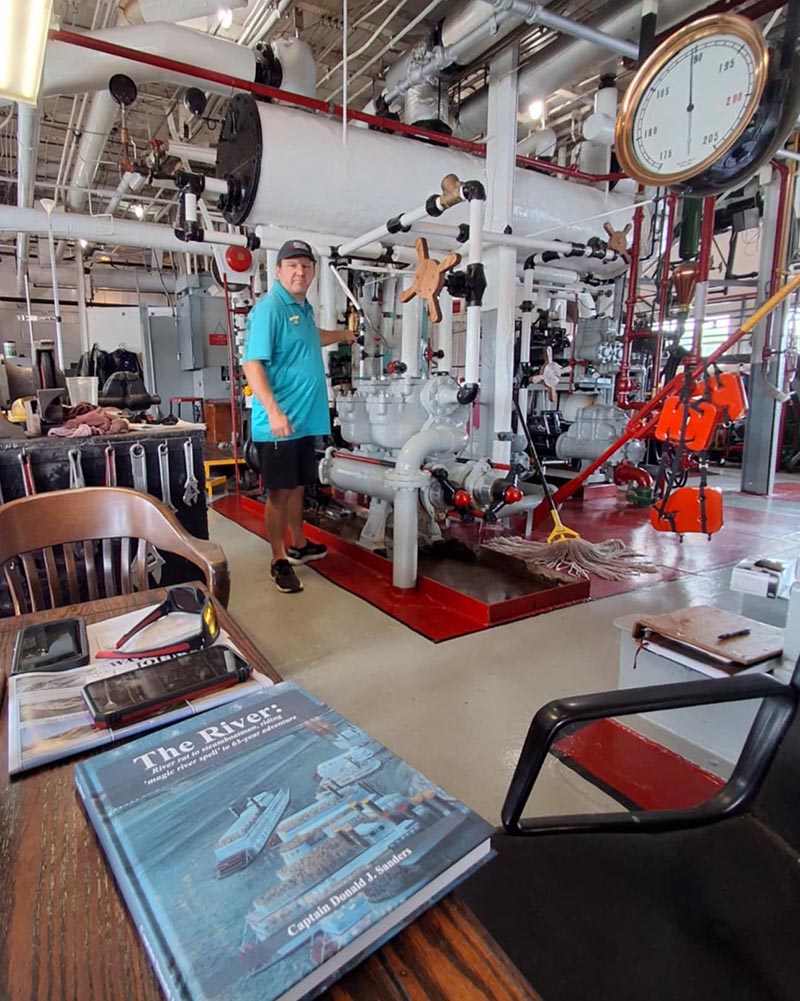
“CLANG-CLANG,” the EOT sounded as Kevin shifted the sawbuck to the down position, dropped the valves, and came ahead on a FULL AHEAD bell. As soon as the BELLE settled into a steady rhythm of returning downstream towards home, Chief Dan’s apprentice placed the engines into the “cutoff” position, and the excitement in the engine room soon settled down.
About that time, Mate Matt Kemp appeared and asked if I would like to visit the pilothouse. Matt certainly didn’t have to bend my arm. But before I left the engineering kingdom, Striker Kevin graciously purchased a copy of my book, THE RIVER, that I carried in the canvas bag — which I greatly appreciated.
Instead of a direct path to the pilothouse, Mate Kemp and I followed a route across the dance floor where the last of the servings for those who paid extra enjoyed a catered meal with their cruise. Two smartly-clad steamboat crew ladies wearing white boat clothing, charged with caring for those special guests, graciously invited me to eat. But, I respectfully declined as the long-term effect of my medical treatments prevents me from eating food I once knew and enjoyed. Again, I was impressed with the courtesy and hospitality that the members of the BELLE’s crew displayed to everyone aboard. I truly felt like an alumnus returning home to his alma mater after a long absence.
“Come on in here,” a familiar voice invited me from inside the pilothouse, which I instantly recognized as belonging to Captain Pete O’Connell, a long-time pilot aboard the BELLE OF LOUISVILLE who started like the rest of us as a deckhand “learning the ropes.” Pete often steered my former boat, the sternwheeler, rafter CLYDE. Pete brought the CLYDE out of Louisville in 2014 to Madison, Indiana, following the 100th birthday bash for the BELLE. Captain Jamie also held court inside the “knowledge box,” as did a young deckhand standing his turn with the duties assigned to deck members aboard that vessel.
By now, the BELLE, paddling through the bridges above her landing, still had to go deeper downstream closer toward the head of the Portland Canal to make a wide sweeping turn upstream to the MAYOR ANDREW BROADDUS, also remembered by old-timers like myself as LIFE SAVING STATION #10, a former U.S. Coast Guard floating facility guarding the Falls of the Ohio River from errant boats mistaking the falls route as a shortcut bypassing the canal and lock.
Like other veteran pilots I remembered from behind the same great, wooden steering wheel, Cap’n Pete continued the banter between us until Captain Jamie announced from the starboard wing bridge his intentions to land the boat. Immediately, all chatter stopped, while Captain Schuchter and I silently observed the landing from the lazy bench.
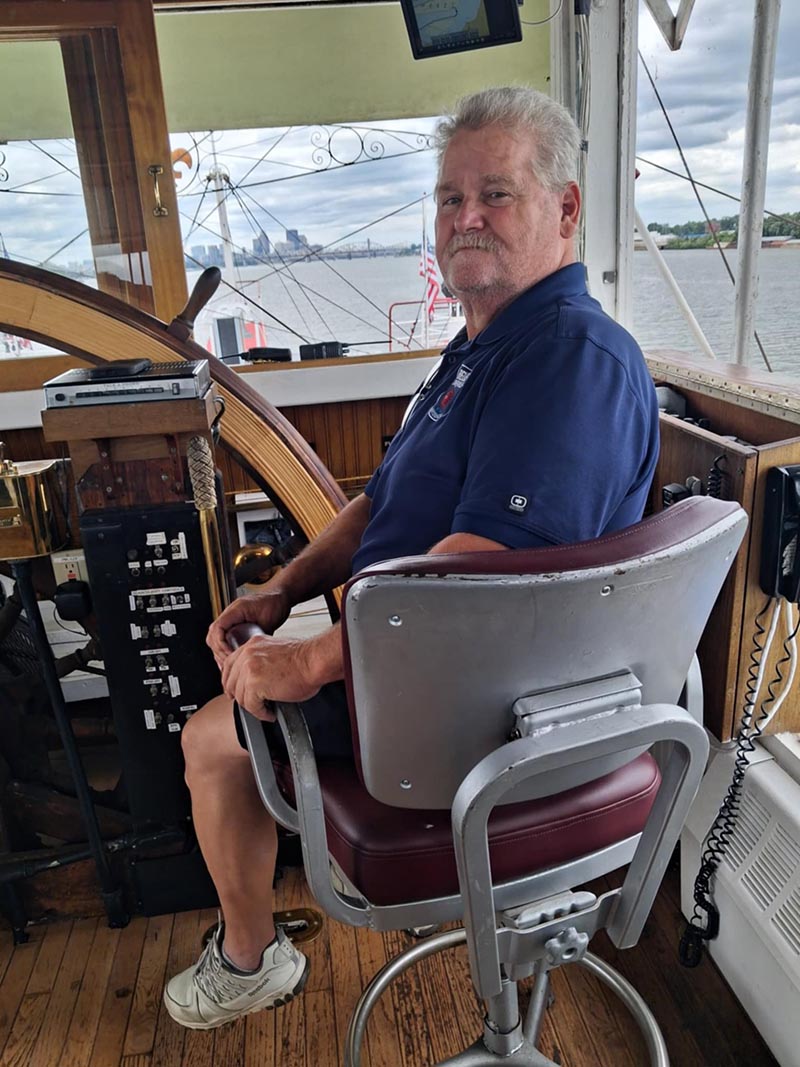
“BACKIN’ SLOW… STERN IN,” came the call from the Captain, which the Pilot repeated through the intercom to the wing bridge and indicated to the engineers via his EOT. “HEAD OUT. ALL STOPPED.”
Meanwhile, down below on the bow, Mate Kemp’s crew sent the headline to a man waiting on the BROADDUS. Quickly, the BELLE now snagged like a giant catfish, maneuvered slowly into place, and settled behind the wharfboat as additional lines went out and held the now resting steamboat in place — another trip for the logbook.
“Who’s going to the Howard Steamboat Museum for Travis Vasconcelos’ program?” I asked. Both Pete and Alex replied that they were going. My original intent for coming to Louisville was to attend the River Ramblings 2025 at the museum, across the river in Jeffersonville, Indiana. The idea for the steamboat ride aboard the BELLE came later when Travis, the director of the Howard, posted that the BELLE OF LOUISVILLE would be running an excursion before his program at the museum.
Although years ago, I scampered around the Louisville/Jeffersonville area like I lived there. But times have changed, as have the traffic patterns as I once knew them. Fortunately, Cap’n Alex knew his way around between the two cities in different states, divided by the Ohio River at its broadest point in its 981-mile course. “I’ll follow you, Alex,” I said. Before too long, Old Blue pulled into the Howards’ parking slips next to the main gate. Minutes later, we walked to the “boathouse,” as I call the structure beyond the palatial former home of the illustrious Howard family, builders of most of the finest steamboats in history, which now houses the museum’s collection of priceless steamboat-related artifacts.
Stepping inside the boathouse, I was amazed to see the transformation the museum had made to the once-shabby outbuilding beyond the main house. In my modest way, I’m happy that besides membership in the Howard, I’ve donated a few bucks that may have gone toward the transformation I observed inside the auxiliary building. What I saw made me proud to be a member of such an energetic river organization.
In the main assembly area, large circular tables and chairs filled the room. Up front, a couple of covered folding tables and chairs with a central speaker’s podium provided sufficient space for the panel of knowledgeable steamboat experts assembled from those experienced enough to talk about the subject. For the River Ramblings 2025 theme, Director Travis chose, “What Does It Take To Run A Steamboat?” Travis included eight questions for the panel in the round table discussions.
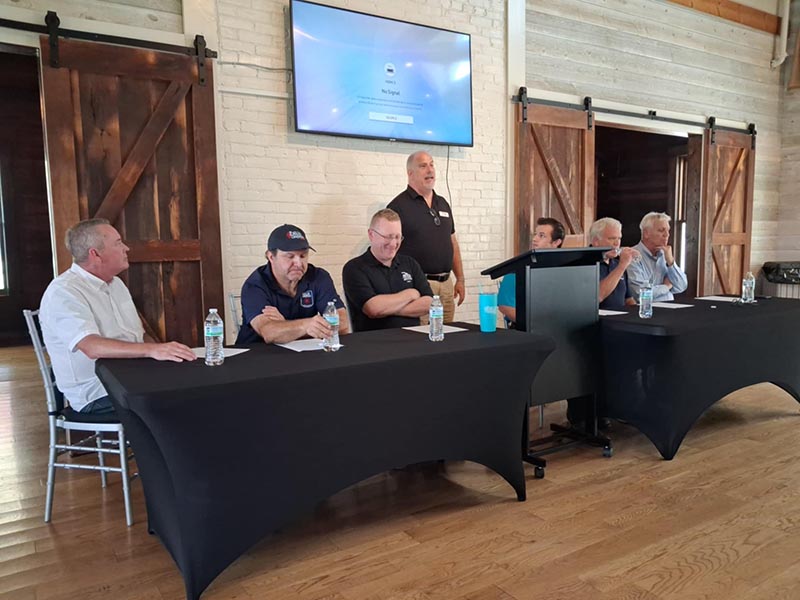
However, before the experts gathered at the front table, Travis presented a detailed history of steamboats on the Western Rivers, as the Mississippi River and tributaries are known. At my request, the director granted me a few minutes to inform the group of the extraordinary news that the late Ed Smith, a beloved fireman on the AVALON and DELTA QUEEN, is one of four finalists for acceptance into the National Mississippi River Museum and Aquarium’s prestigious “National Rivers Hall of Fame.” Several of those within the room, including me, worked and were mentored by the extraordinary African-American steamboat man from St. Louis.
Once I finished talking about Ed Smith, Travis called Capt. Greg Brown, Chief Dan Lewis, Mate Matt Kemp, Lead Deckhand Avery Cox, Chief Mike Fitzgerald, and Captain Kevin Mullen to the expert’s table. The eight questions presented to the steamboat men could be the subject for an entire column in my weekly River series. So I may save the details of the eight questions for another time.
From remarks I heard during the limited steamboat trade, it is fortunate to have such gifted participants among its ranks. At least one member, however, plans to retire soon, as does a licensed member among the audience seated beyond the experts’ table. Still, Matt Kemp is a young man coming up, as is Avery Cox.
After the program, I talked with Avery, emphasizing the importance of obtaining a U.S Coast Guard license to cover the BELLE OF LOUISVILLE. I felt the desire within the youngster to continue to keep the old, but glorious, steamboat running. After all the chatter — among old friends and new — following the program ceased, I invited Avery to follow me to Old Blue, where I had another copy of THE RIVER, which I opened and explained what several of the stories contained before presenting it to him. He may likely write his book someday about his career on a much older steamboat named the BELLE OF LOUISVILLE.
The ride home was a doozy following my GPS through the backroads of Indiana between miles of rows of tall green corn intersected by gravel-paved sideroads — but that, too, is a story for another time.
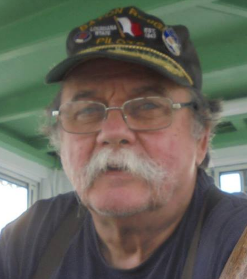 Captain Don Sanders is a river man. He has been a riverboat captain with the Delta Queen Steamboat Company and with Rising Star Casino. He learned to fly an airplane before he learned to drive a “machine” and became a captain in the USAF. He is an adventurer, a historian and a storyteller. Now, he is a columnist for the NKyTribune, sharing his stories of growing up in Covington and his stories of the river. Hang on for the ride — the river never looked so good.
Captain Don Sanders is a river man. He has been a riverboat captain with the Delta Queen Steamboat Company and with Rising Star Casino. He learned to fly an airplane before he learned to drive a “machine” and became a captain in the USAF. He is an adventurer, a historian and a storyteller. Now, he is a columnist for the NKyTribune, sharing his stories of growing up in Covington and his stories of the river. Hang on for the ride — the river never looked so good.
Purchase Captain Don Sanders’ The River book

Capt. Don Sanders The River: River Rat to steamboatman, riding ‘magic river spell’ to 65-year adventure is now available for $29.95 plus handling and applicable taxes. This beautiful, hardback, published by the Northern Kentucky Tribune, is 264-pages of riveting storytelling, replete with hundreds of pictures from Capt. Don’s collection — and reflects his meticulous journaling, unmatched storytelling, and his appreciation for detail. This historically significant book is perfect for the collections of every devotee of the river.
You may purchase your book by mail from the Northern Kentucky Tribune — or you may find the book for sale at all Roebling Books locations and at the Behringer Crawford Museum and the St. Elizabeth Healthcare gift shops.
Click here to order your Captain Don Sanders’ ‘The River’ now.

